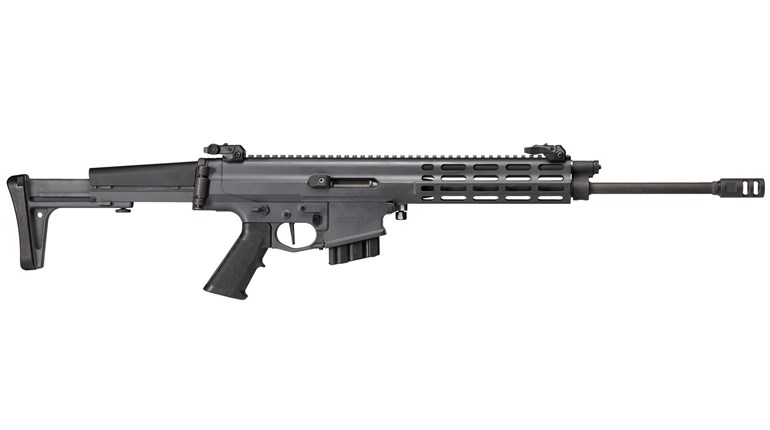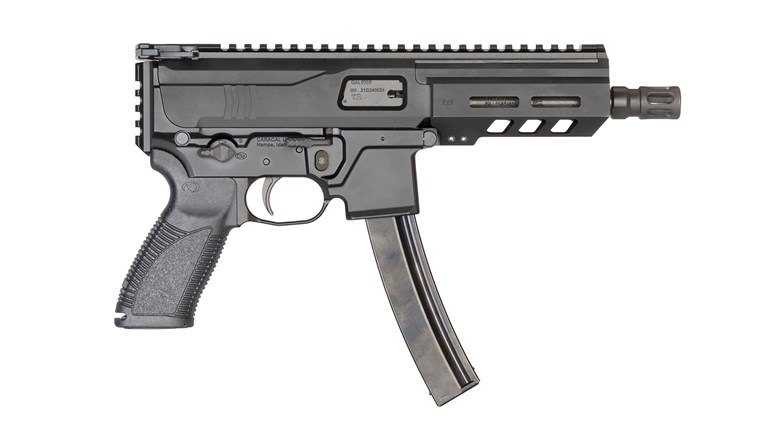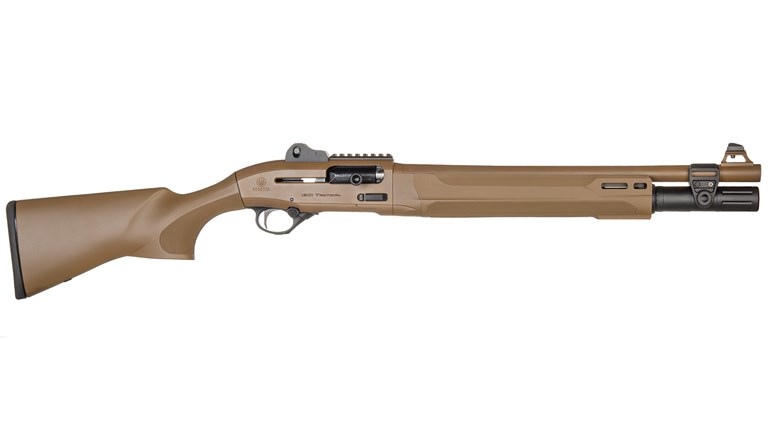
Smith & Wesson M&P 15-22 owners can now enjoy a much quieter shooting experience using an integrally suppressed upper receiver from the company’s Gemtech suppressor brand. The Integra 15-22 is a complete upper receiver designed only for the M&P 15-22 lower receiver. Aside from the barrel and suppressor, the Integra shares the same features used on the M&P 15-22 Sport rifle, including a chrome-plated bolt and polymer upper receiver, charging handle and handguard with full-length accessory rail on top and M-Lok mounting slots on the other three sides.
The Integra is just .25 inch longer than the upper used on the unsuppressed M&P 15-22 Sport and, weighing 2.7 pounds, is nearly weight-neutral. Both uppers have the same chamber dimensions and 1:15-inch rifling, but the Integra’s barrel is only 9 inches long and is pinned and welded to a 7.9-inch monocore baffle. The permanent attachment of the barrel to the core provides the 16-inch minimum length of the barrel-suppressor combination to avoid treatment of the fully assembled firearm as a short-barreled rifle. That saves it from being a “two-stamp” product, since you’ll still need to go through the NFA process to buy the Integra.

The Integra isn’t Gemtech’s first integral rimfire suppressor and its design emulates the company’s Mist suppressors made for Ruger 10/22 rifles with a black-oxide-finished, 17-4 PH stainless steel core enshrouded by a .925-inch-diameter aluminum tube. The tube extends back behind the core to cover the barrel and is secured by a thread mount just forward of the chamber. A threaded end cap seals the tube up front without attachment to the core.
Though the tube fits snugly over the core, there’s no gas seal inside so a small portion of the combustion gas bleeds back into the void between the tube and the exterior of the barrel. The additional volume aids sound reduction, but at the expense of a minor amount of powder fouling and lead accumulating in harder-to-clean areas. The more vexing aspect of maintenance, however, is accessing 2.25 inches of the core that sits within the handguard and ultimately makes a thorough cleaning quite tedious. Removing the handguard is not a practical option, as the operation requires special tools and Gemtech advises against it. Another hindrance to cleaning is the end cap has very little surface area to grasp and no knurled edges or wrench flats to facilitate its removal once even minor amounts of powder fouling and lead accumulate. Thus, it is susceptible to damage if removal involves a vise grip or similar tool. Given these challenges, we recommend lubricating the threads on both ends of the tube before you start shooting. Also, as with all non-shielded suppressor cores, lead and carbon fouling will accumulate and make tube removal difficult, so unscrew the tube and end cap immediately after each range session, no matter how brief.
I tested the Integra using an M&P 15-22 Sport lower receiver with three questions in mind: How quiet? How accurate? How reliable? Three subsonic and one high-velocity load were used. Gemtech cautions against using 60-grain loads, because the rifling won’t stabilize them and could cause baffle strikes, so the heaviest used was Winchester’s 45-grain Super Suppressed. Another caution is not to run the can wet, but no reason was provided other than this can is effective enough not to need it, a perception our testing seemed to confirm as the sound of the bolt’s movement was apparent to the shooter using subsonic ammo. Gemtech also told us that from the shooter’s perspective, the noise from the bolt slap is louder than the muzzle blast using Gemtech 42-grain subsonic ammo. We couldn’t obtain this load to verify that claim, but we did use a sound meter placed near the shooter’s ear to compare the report of the Winchester load to the sound of the bolt slap alone. The gunshot measured an undiscernible 1 to 3 dB louder than the bolt slap alone.
Gemtech’s sound-testing data is solid, but caution is advised if comparing it to other companies’ testing, as the measurements are taken using C-scale weighting, which cannot be compared with unweighted measures that many testers use. In any event, this suppressor reduces noise impressively with a rare first-round pop that was so minor, it could only be detected by the meter.
Accuracy and ammo preference were tested firing off a Caldwell Precision Turret rest at 50 yards using a Leopold Mark IV 10-25X scope. Here, the Integra delivered only plinking-level accuracy, with mean five-shot groups ranging from 1.77 to 2.20 inches. I was curious as to how accurately an unsuppressed M&P 15-22 Sport shot the CCI Standard Velocity and Remington Target ammo, and discovered that the CCI load performed much better, with average and best groups of 1.25 inches and 1.06 inches respectively, while the Remington load grouped about the same. Another interesting comparison shows minimal diminution in velocity of 21 to 85 fps between the Integra with its 9-inch barrel and the M&P 15-22 Sport with its 16.5-inch barrel. Finally, the Integra exhibited solid reliability with the only stoppages being five failures to eject in 200 rounds fired. For a rimfire semi-automatic, that’s actually pretty decent performance.
Overall, the Integra is a viable choice for M&P 15-22 owners who seek a plinker that really takes the edge off muzzle blast and don’t mind its longer-than-average maintenance time.





































